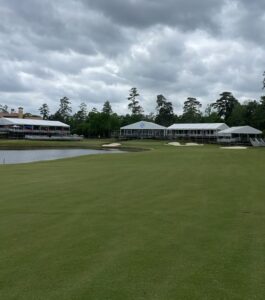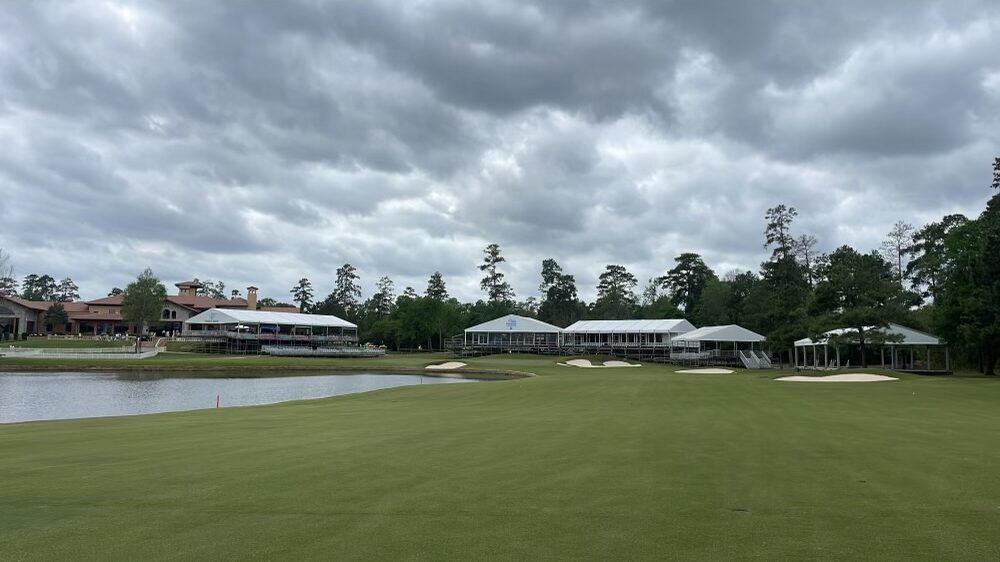The Jack Nicklaus Signature Course at the Club at Carlton Woods has hosted the LPGA’s Chevron Championship for the second consecutive year. The golf course opened in 2001 and has hosted numerous prestigious events such as:
- the USGA State Team Championship in 2007
- the 67th U.S. Junior Amateur in 2014
- the 107th Southern Amateur in 2017
- the LPGA Tour Chevron Championship starting in 2023
The Nicklaus course underwent a restoration in 2023 under the Nicklaus Design Group and was overseen by Chris Cochran. They redid all 18 greens, along with all the green surrounds, bunkers and tee boxes; they also fraze mowed the fairways and installed new irrigation, in addition to adding and subtracting bunkers, tee boxes and trees throughout the golf course.
Meghan Musk, the Assistant Golf Professional at The Club at Carlton Woods, shares her intimate knowledge of this golf course with those of us who can only watch the Chevron Championship through a TV screen.
Hole #1: Par 4
The opening hole is challenging with a fairway bunker on both the left- and right-hand side. Long hitters can take it over the left fairway bunker and have a wedge in. Many will choose to lay up short of the right bunker and have a mid-iron in. Players do not want to miss short right as it will leave a difficult into-the-grain Bermuda chip to an elevated green; missing long is also undesirable as the green runs away from the player.
Hole #2: Par 4
This is a long hole with a fairway bunker on the lefthand side. Long hitters can carry the crest of the fairway and catch the downslope, which will leave a short club in. Shorter hitters will have a long iron or wood into the green with greenside bunkers along the righthand side. The miss is short left, leaving an uphill pitch with plenty of green to work with.
Hole #3: Par 3

The restoration flattened this green and significantly shortened the space between the green the penalty area. The green is very shallow and if players miss long into the back greenside bunker, they are faced with a nearly impossible bunker shot with the green running away from the players. The miss is short right, leaving a flat chip with plenty of green.
Hole #4: Par 5

The restoration shifted the tee boxes to the left side near the water. Two fairway bunkers are on the righthand side of the fairway to catch any drives that bail out right to avoid the water. Players who try to go for the green in two are met with a well-guarded green with greenside bunkers. The fairway also narrows up around 100 yards in with trees on both side of the fairway defending the green from a layup shot.
Hole #5: Par 4
Long hitters can carry the three fairway bunkers on the righthand side to have a short iron into this green. This tee shot sets up perfectly for a fade, but the water comes in closer than players think, with the fairway also sloping towards the water. Greenside bunker left catches any balls that may be heading towards the water, and a well-placed greenside bunker on the right catches any bailout shots. The miss is short right with a fairly simple chip to the green.
Hole #6: Par 4
This is a short par-4 with fairway bunkers down the left side and a tree-lined fairway down the right. Long hitters will have a flip wedge into a turtle-back green. Laying back short of the bunkers on the right will leave a mid-iron in. The greenside bunker short left leaves a difficult shot into an elevated green that runs away from the player. The miss is long with a fairly simple chip back onto the putting surface.
Hole #7: Par 3
This hole is quite sneaky what with the ridge running through its center. A right pin is the most difficult location on the green, and getting a shot to hold on these new greens is challenging. Bunkers guard the green on all sides, making the miss into the bunkers short in order to have an uphill lie in the sand.
Hole #8: Par 5

This hole claims the most changes during the restoration. They extended the waste bunker in order to create a split fairway. Long hitters will be able to carry the “finger” and have a good look in going for the green in two. Players who lay back off the tee face another layup, and the waste bunker down the left comes more into play than the players think. Two good shots create a solid opportunity to get a shot back.
Hole #9: Par 4
A fairway bunker, sitting perfectly to catch any stray drives, was added to this hole to provide more of challenge for players. Water down the righthand side pushes players towards the bunkers; the fairway also narrows up at this point. This hole plays about a half-club longer from the fairway into the green. The miss is short left for a great chip back onto the putting surface.
Hole #10: Par 4

This is a difficult driving hole with water down the left, trees down the right and a fairway that slopes right to left. Long hitters can challenge the narrowing fairway for a short shot in. Players can also take 3-wood off the tee to a wider landing area. The miss is right, as the approach area feeds down left back onto the green.
Hole #11: Par 4
A long par-4 with parallel lines of trees going down both sides of the hole, strategic (and lucky) players can be rewarded with a short-iron in if they can carry the ridge in the fairway and find the speed slot. This green slopes right-to-left, so the miss is to the right since the ball can funnel back down left to the green.
Hole #12: Par 3
A short par-3 over shallow water, this hole looks like it plays downhill but is actually pretty flat. A well-placed bunker short of the green easily traps your ball if you don’t hit enough club. Hitting a shot long is not ideal as the green runs away from the players. A short-left miss leaves the player with a simple chip back onto the green.
Hole #13: Par 5
This great par-5 has a small, undulating green. Players can challenge the fairway bunker on the left to have a good chance of going for the green in two. The fairway bunker on the right doesn’t seem like it comes into play, but it has been known to catch a few shots not struck solidly, leaving an impossible third shot into the green. Any shots that land in the right half of this green funnel off into a collection area right of the green, setting you up for a very difficult chip up. The miss is left, but even that doesn’t guarantee an easy up and down.
Hole #14: Par 4
Mid-short hitters can’t reach the fairway bunker on the right and usually have a mid-long iron into the green. Long hitters can carry the bunker and for a short shot in. This green runs front-to-back, making a miss long and left difficult to chip back onto a green that runs away from the player. The miss is definitely short or in the greenside bunker short right of the green.
Hole #15: Par 4:
This is the signature hole at the Nicklaus golf course. A creek runs down the lefthand side of the fairway and then cuts to in front of the green. If players carry the ridge of the fairway, they’ll be left with a short iron into this green. Shorter hitters that go right are met with trees and out-of-bounds. The bailout is left of this green, as any shots long are met with a green running away from the player into the water.
Hole #16: Par 4
This dogleg right par-4 with a waste bunker running down the left has a well-placed fairway bunker directly at the dogleg. Long hitters can carry this bunker, leaving them with a short iron into a two-tiered green. Lots of players bail out right and are once again met with trees and out-of-bounds. The miss to this green is right, but players may also encounter a greenside bunker there.
Hole #17: Par 3
This uphill par-3 has a ridge running through the middle that players can use to their advantage if the pin is on the left. The short greenside bunker catches lots of shots because players are trying to avoid the bunker on the left. The miss is short right of this green, which gives players plenty of green to work with.
Hole #18: Par 5

This is a great finishing hole that gives the players lots of opportunities, like we saw last year with the playoff between Lilia Vu and Angel Yin. If the tee is moved up, players can easily go for the green in two but are met with water short (just ask Angel Yin). Trees and a fairway bunker guard a dogleg right before the fairway comes back left. Well-placed fairway bunkers down the righthand side guard layup shots and leave an awkward third shot into the hole. Typically, the miss is long or left, but with grandstands, players are able to “ship” shots into the stands and get TIO relief. This hole offers great fireworks for Sunday’s conclusion of the LPGA major championship.



